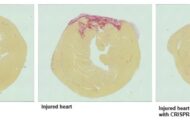via Trinity College Dublin
Bioengineers from Trinity have developed a prototype patch that does the same job as crucial aspects of heart tissue.
Their patch withstands the mechanical demands and mimics the electrical signalling properties that allow our hearts to pump blood rhythmically round our bodies. Their work essentially takes us one step closer to a functional design that could mend a broken heart.
One in six men and one in seven women in the EU will suffer a heart attack at some point in their lives. Worldwide, heart disease kills more women and men – regardless of race, than any other disease.
Cardiac patches lined with heart cells can be applied surgically to restore heart tissue in patients who have had damaged tissue removed after a heart attack and to repair congenital heart defects in infants and children.
Ultimately, though, the goal is to create cell-free patches that can restore the synchronous beating of the heart cells, without impairing the heart muscle movement.
Michael Monaghan, ussher assistant professor in biomedical engineering at Trinity, and senior author on the paper, said:
“Despite some advances in the field, heart disease still places a huge burden on our healthcare systems and the life quality of patients worldwide. It affects all of us either directly or indirectly through family and friends. As a result, researchers are continuously looking to develop new treatments which can include stem cell treatments, biomaterial gel injections and assistive devices.”
“Ours is one of few studies that looks at a traditional material, and through effective design allows us to mimic the direction-dependent mechanical movement of the heart, which can be sustained repeatably. This was achieved through a novel method called ‘melt electrowriting’ and through close collaboration with the suppliers located nationally we were able to customise the process to fit our design needs.”
This work was performed in the Trinity Centre for Biomedical Engineering, based in the Trinity Biomedical Sciences Institute in collaboration with Spraybase®, a subsidiary of Avectas Ltd. It was funded by Enterprise Ireland through the Innovation Partnership Program (IPP).
Dr Gillian Hendy, director of Spraybase® is a co-author on the paper. Dr Hendy commended the team at Trinity on the work completed and advancements made on the Spraybase® Melt Electrowriting (MEW) System.
The success achieved by the team highlights the potential applications of this novel technology in the cardiac field and succinctly captures the benefits of industry and academic collaboration, through platforms such as the IPP.
The Latest Updates from Bing News & Google News
Go deeper with Bing News on:
Heart patch
- Pet of the Week: He has a heart of gold and is ready for his forever home!
Our Pet of the Week is Patch, a five-year-old American Blue Heeler/Rottweiler, and just one of the many animals available at the Humane Society right now.
- School Bus Cameras; Community's Heart; Good Samaritan: Daily Digest
The article School Bus Cameras; Community's Heart; Good Samaritan: Daily Digest appeared first on Nyack-Piermont Patch.
- ‘My heart dropped’: Woman shares warning on viral turmeric soap after it ‘burned’ her face
In the comments section, numerous viewers shared similar experiences. One commenter said the soap left her with scarring, while another said it “irritated [her] face so bad it burned.” Others ...
- 'A Heart As Big As This World': Firefighter Mourned On LI
A former Marine and FDNY firefighter who called Lindenhurst home died in his residence on April 15, those who loved him have confirmed. Anthony Caliendo, 29, was an FDNY firefighter for five years who ...
- The 10 Best Forehead Wrinkle Patches to Make Fine Lines Disappear
A lesser-known fact about wrinkles and fine lines is that they are not exclusively signs of aging but can also be signs of skin dehydration. These patches are made with a blend of ultra-hydrating ...
Go deeper with Google Headlines on:
Heart patch
[google_news title=”” keyword=”heart patch” num_posts=”5″ blurb_length=”0″ show_thumb=”left”]
Go deeper with Bing News on:
Artificial heart tissue
- Medtronic launches next-gen surgical aortic tissue valve
Medtronic (NYSE: MDT) today announced the launch of its next-generation Avalus Ultra surgical aortic tissue valve.
- The first blueprint for building an artificial ovary
With greater insight into the developmental process of follicles, the team is hopeful that they will be able to trigger cells into maturity and produce optimized artificial ovarian tissue, which can ...
- At last: a real bionic heart
The first prototype contained plastic struts to attach the artificial heart to body tissue,' she says. 'But in autopsies, we found what looked like a build-up of blood in the struts which could ...
- An artificial womb could build a bridge to health for premature babies
Artificial wombs could someday save babies born very prematurely. Even though the experimental technology is still in animal tests, there are mounting questions about its eventual use with humans.
- Artificial Integrity
Artificial Intelligence may be the most evocative ... can lead to greater and stronger integrity, at the heart of all our societal systems. The enhancement of our human capacities in service ...
Go deeper with Google Headlines on:
Artificial heart tissue
[google_news title=”” keyword=”artificial heart tissue” num_posts=”5″ blurb_length=”0″ show_thumb=”left”]







